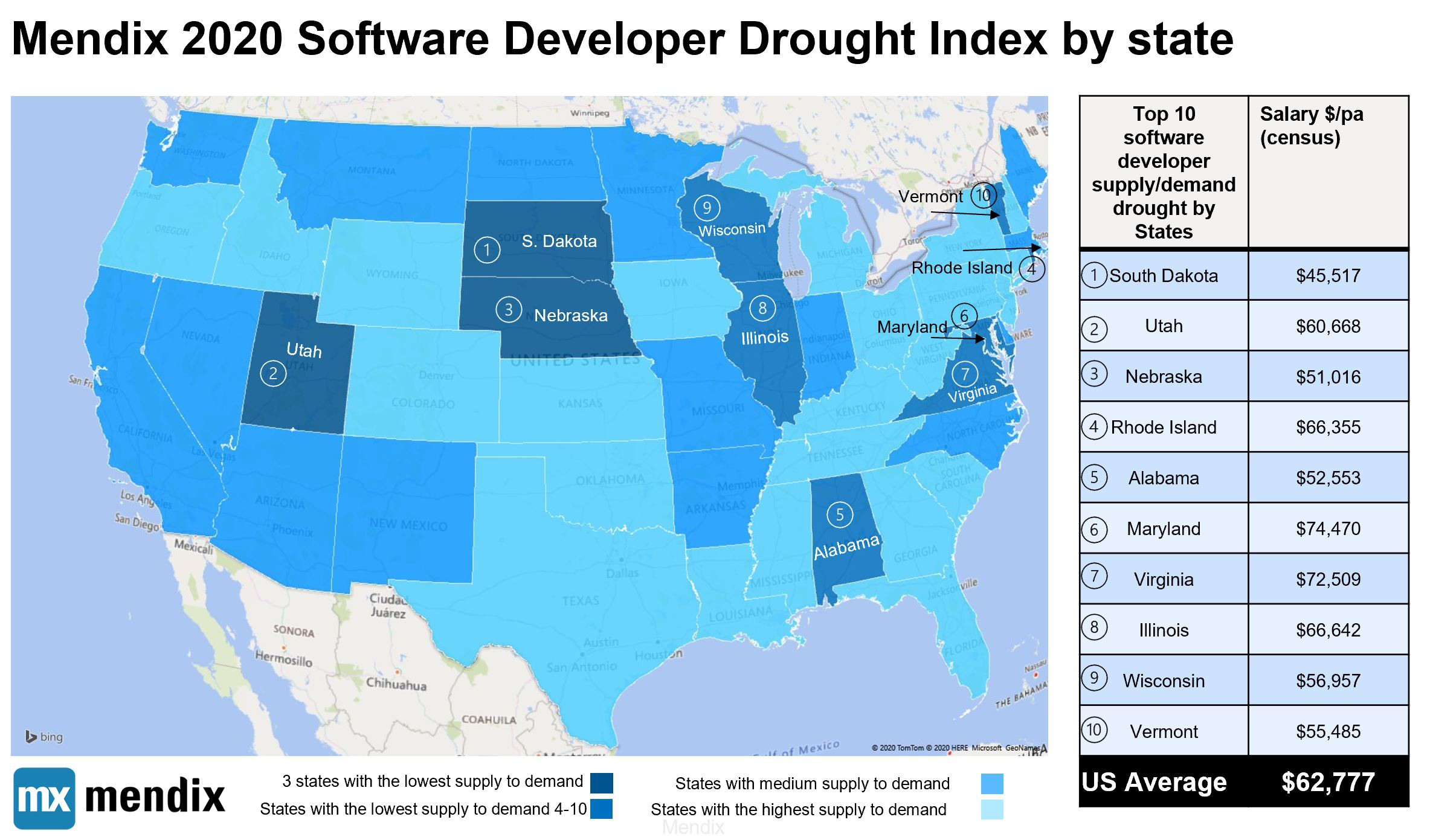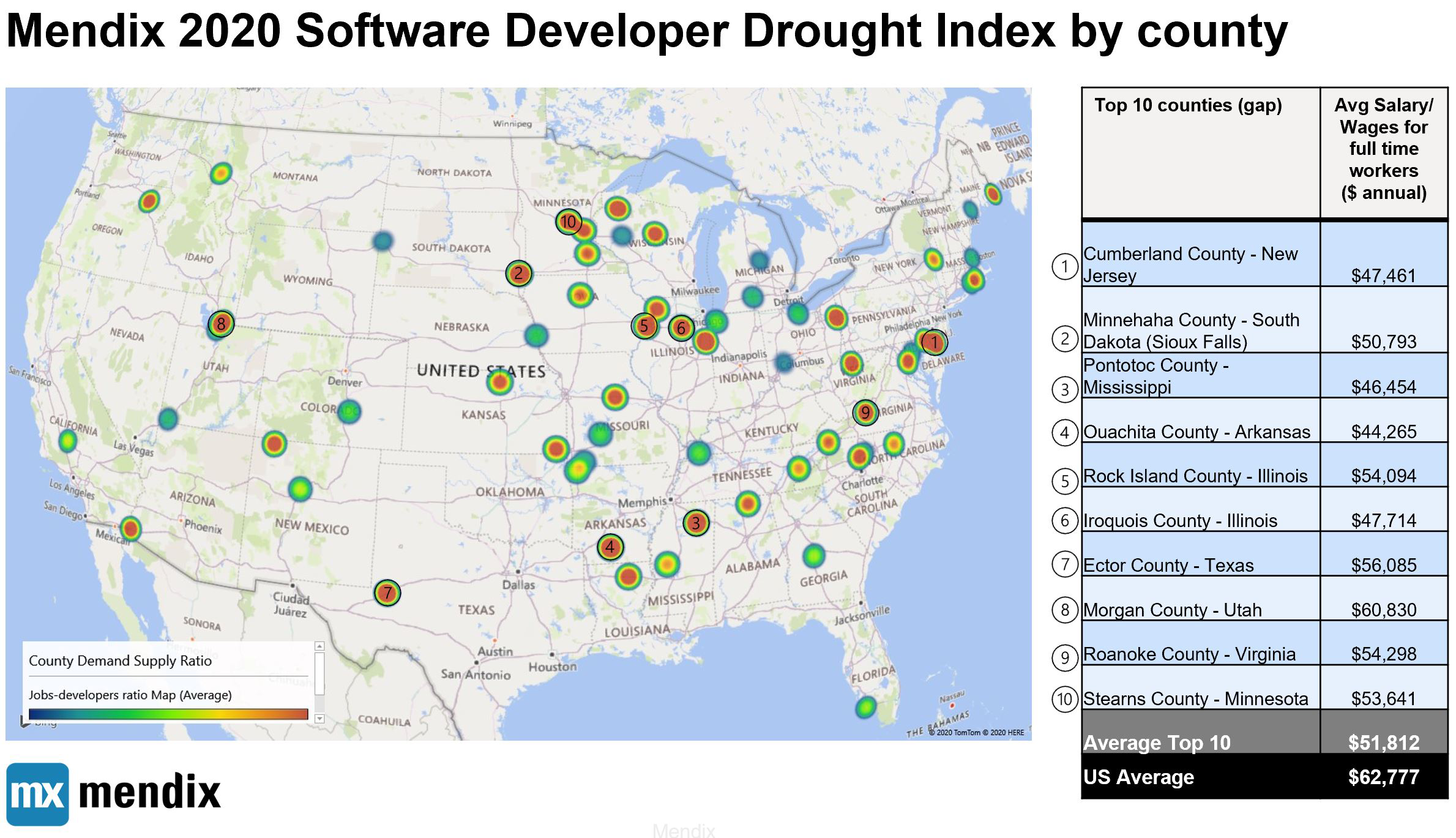Mendix 2020 Software Developer Drought Index Reveals Unexpected Hiring Hotspots and a Changing US Map of Tech Talent Scarcity and Needs
Despite COVID-19, states in the US heartland are actively hiring developers. Meanwhile, professionals on the coasts are reassessing work-life opportunities and exploring start-up opportunities outside Silicon Valley and other tech hotspots
Eight out of 10 US counties with the highest “Developer Demand” shortage are in states in the middle of America, such as South Dakota, Missouri, Arkansas, Illinois, Utah, and Mississippi
92% of job ads on three leading sites for software developers in July/August were for specific locations, showing employers are slow to embrace remote working opportunities
BOSTON – AUG 27, 2020 – Mendix, a Siemens business and global leader in low-code application development for the enterprise, today announced the launch of the ‘Mendix Software Developer Drought Index,’ which reveals where the hiring shortage is most critical for developers at a U.S. county and state level.
An analysis of over three million U.S. households (American Community Survey), combined with a detailed geo-analysis of over 2,000 job ads for U.S. software developers in July 2020 revealed new patterns spotlighting areas of the highest demand, but with the least supply of software developers nationally. On a state level, the gap between supply and demand is most significant in middle America, with some exceptions. At a county level, the highest Developer Demand is in Cumberland County, NJ (outside Philadelphia), Minnehaha County, SD (Sioux Falls), and Pontotoc County, MS (Tupelo). Well-known tech hubs such as Fairfax, Virginia, and Silicon Valley, California, have a better balance – these areas have the highest demand, but also the highest supply of talent. (See below for geographical information).
These findings reveal opportunities for companies and individuals to decentralize talent away from established tech hubs using virtual teams and cloud technology. As firms move to outer locations with lower office/home rents, we might expect U.S. tech talent to relocate to these new hotspots of tech growth and start-up innovation — reinforced by recent migration away from dense urban centers during the COVID-19 crisis.
However, tech companies offering jobs in Developer Drought locations must also consider the recent acceleration towards remote working, prompted by COVID-19. Google recently announced an extension of home working for its employees until July 2021, and Facebook has said that it would allow many employees to work from home permanently. Yet surprisingly, 92% of the job ads analyzed required a specific location. While industry leaders are reassessing the remote work landscape, other tech companies are slower to adjust to new post-pandemic realities.
Companies located in or moving to Developer Drought locations may have an increased interest in software solutions that can bridge the tech talent gap. For example, low-code solutions can democratize and speed up software development by empowering staff who do not have specialized coding expertise, and are not in the IT department, to build software solutions.
Derek Roos, CEO of Mendix, says, “The Software Developer Drought Index shows that companies need to think differently about how and where to engage skilled tech workers in 2021 and beyond. Traditional development paradigms basically fall apart when you’re dealing with mobile or remote workflows. Low-code platforms like Mendix help customers scale software development capability across the whole enterprise and leverage the cloud to provide collaborative software development wherever people choose to live.”
Further geographical information:


Leading Developer Drought Counties
Cumberland County, NJ: The US county with the highest developer demand, Cumberland County, New Jersey, offers an average wage of $47,461 – the third lowest of the top 10 Developer Drought counties. This is despite average rental prices being the third highest at $833. Cumberland County’s proximity to Philadelphia, Washington, D.C., and New York make it an increasingly attractive location for companies to operate from.
Minnehaha County, SD: Part of the emerging “Silicon Prairie,” Minnehaha County has the second-highest developer demand. Big players, including PayPal, are currently hiring in Sioux Falls, South Dakota ), and cases of COVID-19 in South Dakota are the lowest in the country. Minnehaha County has an average commute time of just 16 minutes, the lowest of the top 10 Developer Drought counties.
Pontotoc County, MS: Pontotoc County has the third-highest developer demand. Despite recent efforts to establish Mississippi as the Silicon Valley of the South, just 0.1% of its population have IT degrees, the lowest of the top 10 Developer Drought counties. Average wages are the second lowest of the top 10 Developer Demand counties ($46,454), but rent is also relatively low at $639 (the fourth lowest of the top 10 Developer Demand counties).
The list of the top 10 Developer Drought Counties is below with links to maps of each one:
| Developer Demand Counties | Avg Wages for Full time workers | Monthly Rent | Travel time to work in minutes | Map link |
| Cumberland County – NJ | $47,461.49 | $833.95 | 23 | map |
| Minnehaha County – S. Dakota | $50,793.94 | $804.55 | 16 | map |
| Pontotoc County – Mississippi | $46,454.42 | $639.46 | 23 | map |
| Ouachita County – Arkansas | $44,265.69 | $415.39 | 20 | map |
| Rock Island County – Illinois | $54,094.59 | $614.45 | 21 | map |
| Iroquois County – Illinois | $47,714.52 | $518.08 | 25 | map |
| Ector County – Texas | $56,085.12 | $857.52 | 25 | map |
| Morgan County – Utah | $60,830.25 | $907.19 | 20 | map |
| Roanoke County – Virginia | $54,298.53 | $761.52 | 22 | map |
| Stearns County – Minnesota | $53,641.92 | $674.08 | 23 | map |
| Grand Total | $51,812.64 | $707.97 | 22 |
Key Takeaways
The tech-based industry managers and workforce, no longer confined to Silicon Valley or other traditional tech hubs, are now beginning to be untethered from any specific geography. The Developer Demand Index pinpoints leading opportunities for companies to leverage remote teams, cloud technology, and low-code software as a new powerhouse strategy for collaborative innovation.
Learn more about the Mendix platform and pricing and availability.
Click here to access content free of charge from Mendix World: Version 2.0, the world’s largest virtual low-code conference, featuring more than 60 sessions, including more than 20 by customers, and covering the gamut of low-code application development topics from strategy to practical, hands-on platform training.
Background
In a pandemic-disrupted world, software is the new lifeblood of our daily lives and the connective tissue holding together the global economy. However, traditional software development takes far too long and very often fails to deliver the results business needs and users love. Even prior to COVID-19 there were simply not enough professional software developers in the world to build all the software currently required. The global pandemic has accelerated and exacerbated what was already a software and business crisis. Enter low-code software development. Low-code from Mendix is a powerful enterprise-grade visual development approach empowering citizen and professional developers to make cloud-native applications more than 10x faster for web and mobile using drag-and-drop components and model-driven logic, all through an intuitive graphical user interface.
About Mendix
Mendix, a Siemens business, is the only low-code platform designed to address the full complexity of enterprise software development challenges. Deploying point solutions to departmental problems solves things at a micro level—but if you want to make a significant impact on your business, you need to go bigger and build powerful portfolios that move the needle sustainably and strategically.
With Mendix, enterprises can take on more complex, transformational initiatives by engaging everyone in capturing requirements, forming ideas, and embedding value assessment throughout the lifecycle of the software portfolio.
Focus on the right problems while relying on governance and control to avoid unnecessary risk. Mobilize your organization. Build the change readiness muscle. And when the next big idea drops, turn it into an outcome quicker.
More than 4,000 organizations in 46 countries use the Mendix low-code platform. An active community of over 300,000 developers has created over 950,000 applications – and counting.